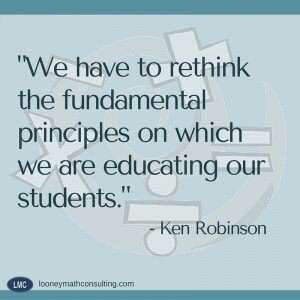Honoring Creativity in the Classroom
My daughter is a senior in high school and is planning on majoring in elementary education.
I have told her repeatedly, “education is the best job in the world!” She has witnessed my love of teaching and appreciated the balanced approach to life that education allows. But, lately, as I share this news with teachers, I keep hearing the same thing … “Tell her no!” I understand. Teachers are overwhelmed and overloaded. The general morale of teachers has suffered with the emphasis on testing, with parents upset by “new” methods of teaching, and with the media adding fuel to this fire. So, how do we hold onto the ideals and the reasons we went into education in the first place? For me, it comes down to honoring creativity – both in our students and as a teacher. Teaching is creative. The opportunity to get to know students, consider what they do and do not understand, and craft that just right lesson or just right question entails having a creative mindset.
Ken Robinson says it quite humorously in his TED talk.(I encourage you to take the 15 minutes to watch this!)
He warns us that “We have to rethink the fundamental principles on which we are educating our students.” He advises us to value creativity.
“Creativity in learning is often highlighted as a skill essential for success in the 21st century."
Daniel Pink (2005) notes that creative thinking is increasingly necessary to accomplish goals in our complex, interconnected world, and education researchers and psychologists tout the social, emotional, cognitive, and professional benefits of possessing creative abilities (Sternberg, 2006). Despite this increased attention to creativity, we still have little understanding of how to nurture and support creativity in current classroom contexts, particularly creative teaching. The U.S. climate of high-stakes testing and scripted curriculums makes it difficult for education stakeholders to infuse creativity into teaching practices (Giroux & Schmidt, 2004).” – from Danah and Mishra.
Let’s consider how to do this in the mathematics classroom.
Mathematics is a highly creative subject matter. Certainly there are things that are givens in mathematics, like, 2 + 2 = 4 – but it is in approaching problems in novel ways that the creativity comes into play. We need to remember to present our students with open task that have multiple solution paths. From Jennifer Piggot, “Creativity in the mathematics classroom is not just about what pupils do but also what we do as teachers. If we are thinking creatively about the mathematical experiences we offer our pupils we can open up opportunities for them to be creative.” We need to use questioning to encourage students to find solutions that build on the knowledge the possess and their natural curiosity. We are fortunate that the internet is full of open resources with lots of problems to consider from sites like nrich,Emergent Math, Three-Act Math from Dan Meyer, and Yummy Math to name just a few. Armed with interesting problems, we can craft questions that encourage thinking.
So, when my daughter talks about being a teacher, we talk with enthusiasm about her future. She imagines a classroom of learners working together to creatively construct their own solutions and understandings. I believe if we are able to find a way to value creativity in education, we will ignite joy in teaching.
And, I still say loudly, “Teaching is the best job in the world!”
Happy March!
Sue Looney, Ed.D.Director of Mathematics Professional Development
Looney Math Consulting
This month's resource publications:
Do Schools Kill Creativity? (TED Talk)




